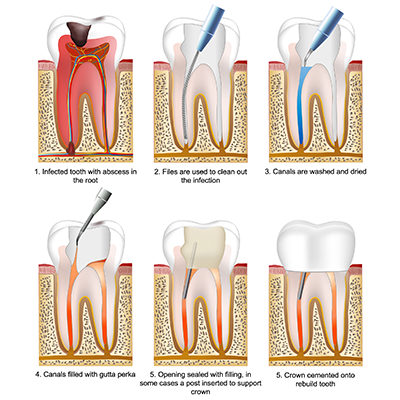If you are one of those who think root canal treatment is a painful and costly dental procedure, this article might change the way you think. Please continue reading below to know more about this helpful dental procedure.

What is a root canal treatment?
A root canal treatment is a dental procedure that is performed to repair and save an infected pulp of a tooth. This is also known as endodontic treatment, endodontic therapy, or root canal therapy. The main purpose of root canal treatment is to eliminate pulp infection and protect the tooth from opportunistic microorganisms.
Root canals, together with their associated pulp chamber are referred to as the physical hollows of a tooth. These hollows are composed of cells, blood vessels, and nerve tissues. All these entities make up a dental pulp.
During endodontic treatment, these structures are removed, and hollows are subsequently shaped, cleaned, and decontaminated using irrigating solutions and small files. The decontaminated canals are then filled with standard filling materials such as gutta-percha – which will be discussed later. A root canal treatment is often complicated and may require you to have multiple visits with your orthodontist.
Does this procedure hurt?
Contrary to popular belief, endodontic therapy is not a painful dental procedure. Patients are given oral anesthesia by a trained dental surgeon. In fact, a regular dental procedure such as wisdom tooth removal is more painful than this. The pain a patient feels actually comes from the pulp infection and not from the treatment itself.
After the procedure, the patient might feel some tenderness, numbness, and a little soreness that may last for 2-3 days. These are temporary and can be treated by over-the-counter pain medications such as Ibuprofen and Naproxen. The doctor may also order prescription meds and antibiotics if necessary.
What are the indications that I might need a root canal treatment?
Typically, dental root canals are recommended to people with a cracked tooth, deep cavity, or dental filling issue. A person whose teeth are sensitive to hot and cold sensations may consider undergoing this treatment.
The following symptoms might indicate a need for a root canal treatment:
- difficulty chewing or swallowing
- moderate-severe pain while chewing or biting
- pimple formation on the gums
- swelling of the gums
- a cracked or chipped tooth
- extreme sensitivity to hot and cold, one that lingers even after the sensation has been removed
- severe gum decay
How much does this treatment cost?
The cost of this dental procedure depends on the severity of the problem and the type (molar, incisor, canine) of an infected tooth. Normally, molars are a little costly since they are more difficult to decontaminate. However, if you will consider its ability to save your tooth, endodontic treatment is relatively cost-efficient. Generally, root canal treatments and tooth restoration procedures are less expensive than complete tooth extractions.
What are the diagnostic tests needed before the actual procedure?
Before the actual procedure, the dentist or orthodontist will perform a series of tests to make an accurate diagnosis and choose the most appropriate treatment for your condition. He will also perform history taking and other clinical examinations necessary to arrive at the most definite medical diagnosis.
These diagnostic tests may include:
- Palpation
- The doctor will perform palpation of the root canal to look for any presence of tenderness or swelling.
- Percussion
- Also called Tender to Percussion (TTP), a percussion test is a method of tapping on the surface of the tooth to see signs of tenderness or inflammation.
- Mobility
- This is a method of assessing other presence of tooth movement in the socket.
- Transillumination
- This test is performed by shining a light through the tooth to check cracks and fractures.
- Tooth Slooth
- This test is performed by instructing the patient to bite down upon a sterile rubber instrument and asking him if it causes pain.
- X-ray
- Radiographs help examine the shape of the root canals and check for signs of infection in the surrounding bone.
The doctor may also require you to undergo dental pulp tests.
How does the actual procedure work?
Root canal therapy is done in three major steps: cleaning the root canal, filling the root canal, and adding a crown or filling.
- Cleaning the root canal
- The dentist/orthodontist will first make an opening through the enamel and dentin tissues using a dental drill. Then he will use a rubber dam to isolate the tooth which will provide a sterile field for operation and protect the patient from possible ingestion of endodontic instruments. After isolating the tooth, the doctor will now remove dead tissues using small files. Finally, the root canal is flushed with an irrigant such as:
- 0.5% – 5.25% sodium hyochlorite (NaClO)
- 2% chlorhexidine gluconate
- 17% ethylenediaminetetraacetic acid (EDTA)
- framycetin sulfate
- saline
- mixture of doxycycline, citric acid, and polyabsorbate 80 (detergent) – MTAD
- near anhydrous ethanol
Chemical irrigation is performed to kill pathogens and dissolve pulp tissues.
- Filling the Root Canal
- Gutta-percha, a natural polymer, is the standard and the most popular filling material. Filling the root canal with gutta-percha can be done in two ways:
- inserting a gutta-percha cone into the decontaminated root canal with a sealing cement
- injecting a melted glutta-percha into the root canal passage/s
Other dental experts temporarily fill the dental canal with a calcium hydroxide paste to fully sterilize the area. After the therapy, the tooth is considered dead since the nerve tissues are already removed and the tooth infection has been controlled.
- Adding a “crown” or a filling.
- It is believed that root canals filled with gutta-percha and sealer can be contaminated in less than thirty (30) days when exposed to saliva. A coronal seal should be maintained throughout the endodontic therapy to guarantee 100% success. Since they are primarily used in chewing, premolars and molars should be secured with a crown that covers and protects the cusps. If not fully sealed, this might cause leakage in the dental canal.
Bear in mind that a root canal treatment can still lead to tooth decay without proper medical and home care and adequate fluoride supply. It is also advisable to have regular radiologic tests to ensure that the tooth is in its perfect condition.
What are the possible complications?
Just like any other medical procedure, dental canal treatment may also bring some complications. These include:
- instrument fractures
- tooth discoloration
- sodium hypochlorite accident
- uncontrolled infection
What are the preventive measures?
Prevention, still, is better than cure. To prevent gum and tooth infections, the following need to be done:
- brushing teeth regularly using fluoride-rich toothpaste
- using a proper toothbrush and replacing it regularly (every 1-2 months)
- flossing
- following a well-balanced diet and avoiding foods that can lead to tooth decay
- attending regular dental consultations and tooth cleaning sessions
After knowing all these facts about a root canal treatment, you can now freely decide whether to undergo this dental procedure or not. The truth is endodontic treatment is not really painful; it is, in fact, a pain-relieving treatment. If you have other questions about this dental procedure, feel free to consult your dentist.


